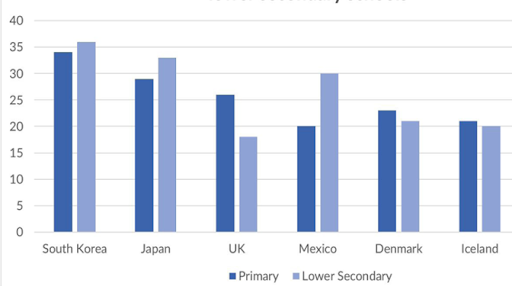average number of students studying in a class
The chart demonstrates the average number of students studying in a class in primary schools and lower secondary schools.
In general, what stands out from the graph is that South Korea had largest average pupil numbers in two types of schools, which was opposite to that of Iceland. Another essential feature is that the biggest disparity was seen in the average number of pupils in primary schools and lower secondary schools in Mexico.
On the one hand, the average figure for South Korea's students per class was lower in primary schools than in lower secondary schools, with approximately 33 and 36 people respectively. Similarly, there was a smaller number of primary pupils studying in than the lower secondary ones in Iceland, with around 28 for the former and 33 for the latter. In contrast, a greater number of 20 students was seen in the figure for lower secondary students, which was a significant distinction.
On the other hand, it is clear that the average figure for primary students was considerably higher than that of lower secondary students in the UK, with a bigger number of about 15 people, while a small difference was seen among both types of schools in Denmark and in Iceland. To be specific, about 23 and 21 in Denmark, and approximately 21 and 20 pupils studying primary schools and lower secondary schools respectively.

unnamed.png
